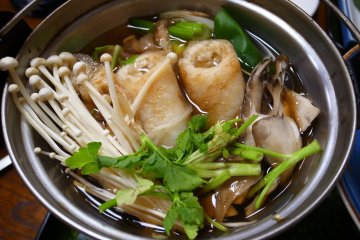Akita, one of Japan’s northernmost prefectures, is a massive region known for its hot springs, vibrant culture, enchanting winters, and natural beauty—from ocean sceneries along the Sea of Japan to lush mountains and plains.
In this prefecture forged by the elements, food has a unique meaning that goes beyond flavor and presentation. It’s rooted in durability, developed to withstand snow-heavy winters through fermentation, preservation, and the careful use of available resources, like mountain vegetables, game meat, seafood, and rice. These hearty cooking methods not only ensured a warm, nourishing meal for daily life but also became interwoven into cultural customs, such as festivals and New Year’s traditions.

As Japan’s sixth largest prefecture, Akita is home to a varied topography, featuring inland basins, a coastal area, and rice-rich plains, all of which receive a healthy coating of snow during winter. Each area has cultivated distinct food practices that still exist today. Now, Akita’s food culture is more than just a method of survival. It holds the stories and wisdom of the prefecture’s past.
Whether it’s pickled vegetables or fish, savory noodles, or a steaming pot of wild vegetables, let’s uncover the meaning and delicious flavors of Akita’s gastronomy.
The relationship between Akita’s food and nature
Snow-covered areas and inland basins
For numerous months every year, Akita is faced with frigid temperatures and heavy snowfall. In the past, these challenging conditions made foraging, hunting, and even leaving one’s home difficult. To survive, people had to adapt and be self-sufficient.
In northern Akita, including modern-day Odate and Kazuno, residents developed preservation techniques for rice and wild vegetables, and the resourceful matagi culture was born. The matagi, traditional hunter-gatherers, have lived in harmony with northern Akita’s nature for over 1,000 years. They salt-preserve fish for winter, gather wild plants, and, most notably, hunt bears. Every slain animal is considered a blessing from the gods, and the matagi use them to the fullest. Nothing goes to waste.

Although the number of matagi has declined in recent years, there are still people who uphold these customs. Tourists can even book tours with matagi to learn more about this meaningful way of life and enjoy traditional dishes like kiritanpo (crushed rice molded onto a cedar skewer and grilled) and bear nabe (hot pot).

Southern Akita, around modern-day Yokote and Yuzawa, also receives thick blankets of snow. Here, people created a globally unique preserved method that combines smoking and fermentation—resulting in a type of pickled vegetable called iburi gakko. During these snowy months, it was difficult to fully sun-dry daikon radishes for pickling. So instead, people chose to dry the vegetables inside their homes over the hearth, resulting in pickles with a smoky element.
The region is also renowned for its flourishing agriculture, spawning numerous processed rice products, and its prestigious Inaniwa udon, one of Japan’s top three types of udon. Miso and soy sauce, some of Japan’s top fermented products, played an important role in the area’s gastronomy as well—serving as the flavor foundation for hot pot dishes and vegetables.
The coast along the Sea of Japan

Akita shares a western border with the Sea of Japan, and in central areas, such as Akita City and Yurihonjo, seafood is abundant. To enjoy these flavors long into winter, people developed fermentation techniques to preserve seafood, creating special foods like hatahata sushi and shottsuru fish sauce. These recipes symbolize the union of seafood and fermentation techniques and have become deeply embedded in the region’s winter celebrations and New Year’s traditions.
Bountiful plains

Resting predominantly in southern and central Akita, the plains have long served as agricultural meccas for rice cultivation. The abundance of high-quality rice gave birth to a food culture centered on this Japanese staple, featuring udon, yakisoba noodles, sake and local sweets—all incorporating rice.
The wisdom of fermentation and preservation
As mentioned above, locals relied heavily on fermentation and preservation techniques to survive Akita’s long winters. This culinary necessity led to the creation of notable Akita dishes that still have a special and important place in the prefecture’s cuisine.

Starting with iburi gakko, this pickled vegetable is a key part of winter in Akita. In Japanese, “iburi” means “smoking” and “gakko” translates to “pickled vegetables”—perfectly summing up the dish. To create iburi gakko, bundled daikon radishes are slowly smoked over a hearth for two to five days. Then, they are pickled in rice bran, salt, and sugar (depending on the family recipe). The resulting food can last all of winter and has a distinct umami flavor rooted in smokiness.

Hatahata sushi is another regional dish born from fermentation. Also called the Japanese sandfish, hatahata are deep-sea fish that migrate to shallow waters near Akita from late November to December. Given its availability and abundance during this time of year, hatahata has long been linked to Akita’s winter traditions. To preserve the bounty of fish, locals created hatahata sushi—hatahata pickled in salt, rice malt and carrots. It is a signature part of Akita’s New Year dinner spreads and is known for its sweet, sour, and umami notes.
Hatahata is also a primary ingredient in shottsuru, one of Japan’s three major fish sauces. To create shottsuru, hatahata are salted and left to ferment for a long time—one to three years! The liquid created during this process is shottsuru. In the past, soy sauce was considered a luxury item, so many people in Akita used shottsuru in its place to flavor their soups and stews.

Although once expensive, soy sauce, as well as miso, are still indispensable in Akita home cooking and preserved foods. Yamamo Brewery, located in Yuzawa, has been upholding historical soy sauce and miso-making techniques since 1867. Today, the brewery offers tours, allowing guests to dive deeper into the world of fermentation, as well as sample a variety of its aged products.
The wisdom of harmonizing with the mountains
In the mountains, Akita’s food culture flows with the seasons and is defined by its sustainable use of available resources.

One dish that perfectly epitomizes this sentiment is bear nabe. During winter, bear meat is a vital source of protein and nutrition. When the matagi take down a bear, they accept it as a blessing from the gods of the forest and respectfully use every part of it—pelt, meat, and organs—so nothing goes to waste. They also forage for wild vegetables in spring following the same ritualistic manner, demonstrating the strong ties between nature, spirituality, and cuisine in northern Akita.
Bear nabe typically includes bear meat, a variety of vegetables, and mushrooms steeped in a broth flavored with sake and miso. The bubbling stew and hearty protein make it a perfect antidote for winter’s icy grasp.

Another food staple in Akita’s mountains is kiritanpo, mashed rice formed around a cedar skewer and roasted over charcoal. This cooking method helped rice last longer and made it more portable for hunting, lumbering, and farming. Alone, kiritanpo has a mild, slightly sweet flavor and a subtle smokiness from the charcoal. People commonly enjoy it in stew (kiritanpo nabe) and slathered with miso (miso tanpo). The versatile dish illustrates Akita’s ability to reimagine and use existing ingredients to the fullest.
The tastes of daily life and festivals
In addition to its deeply nature-entwined food, Akita is home to numerous historical and modern-day dishes that have become core parts of its culinary legacy.

First, let’s travel back to the mid-1600s, when Inaniwa udon was born. This type of udon is hand-stretched rather than cut with a knife, resulting in noodles that are thinner and flatter than typical udon. It has been celebrated in poetry as an artistic masterpiece that melds food and culture. In fact, the noodles were so highly regarded that daimyo (feudal lords) in Akita would often present them as gifts to the Shogun during the Edo period (1603–1868). The elegant noodles can be enjoyed cold or hot, making them suitable for year-round consumption, and are beloved for their soft, yet firm texture and silky mouthfeel.

On the topic of noodles, Yokote yakisoba is another must-try regional dish. This local variety of yakisoba is said to have originated around 1950. Generally, yakisoba features thick, straight noodles stir-fried with cabbage, pork, and a sweet-savory sauce. What sets Yokote yakisoba apart is its additional toppings—Fukujinzuke pickled vegetables and a sunny-side up egg. The dish’s affordability and deliciousness quickly made it a local favorite, and today, it is considered one of Japan’s “Big Three” yakisoba types.

While winter is one of Akita’s defining times of year, summer offers the chance to try its delicious and visually stunning Baba-hera ice cream. Vendors selling this sweet treat pop up all over the prefecture’s major streets during summer and are run by charming elderly women, called Baba in the Akita dialect. The women use metal spades, called hera, to artistically mold the ice cream—generally pink and yellow-colored—into a rose or tulip. It is an artistic masterpiece almost too lovely to eat.
Let’s wrap up our culinary journey with a look at Akita’s high-quality sake. Blessed with pristine groundwater, locally grown rice, and cold weather for brewing, Akita is one of Japan’s top sake-producing prefectures and is known for its innovative brewing techniques. Its sake, which has a deep, smooth flavor, is an integral part of festivals and the local food culture and pairs beautifully with almost all of the aforementioned dishes.
Akita: Remarkable cuisine shaped by nature
In Akita, a simple dish, such as a pickled vegetable, roasted rice cake, or hearty stew, is so much more than just a delicious meal. It is the preserved stories of Akita’s past, shaped by how people lived and adapted to their environment. Different regions transcribed different stories, all of which are reflected in the recipes still passed down today. Visitors can taste fermentation and preservation techniques born from harsh winters and savor mountain cuisine that is spiritually and naturally connected to the land. Recent additions to Akita’s culinary tapestry, such as Yokote yakisoba, prove that its food culture is still changing and evolving with the times.
Taste the wisdom, history, and nature of Akita in every bite.




















